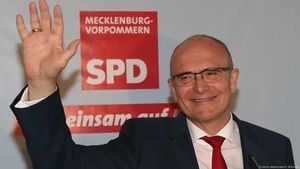The German parliamentary elections are set to take place on February 23, 2025, following the collapse of the previous three-party coalition government known as the "traffic light" coalition. With significant electoral reforms implemented, the upcoming elections promise to reshape the country's political scene, involving fewer parties and candidates than seen previously.
According to the Federal Statistical Office, approximately 59.2 million individuals are eligible to participate, which is about 1.2 million fewer than during the 2021 elections. Of these, about 30.6 million are women and 28.6 million are men. Excitingly, around 2.3 million voters will make their way to the polls for the first time—representing about 3.9 percent of the total electorate. Nonetheless, due to the early election date, about 400,000 fewer young people are eligible to vote this year as they have not yet turned 18.
After electoral reforms, the Bundestag will see its number of members reduced to 630 at maximum. The 21st Bundestag is projected to have over one hundred fewer MPs compared to the current 733 deputies. Notably, this electoral shift now means the second vote will solely dictate the allocation of seats within parliament.
Participatory dynamics have changed with only 29 parties taking part this election, significantly down from the 47 parties represented during the last elections. The major parties contesting for state lists across all 16 German states include the Social Democratic Party (SPD), the Greens, the Free Democratic Party (FDP), the Alternative for Germany (AfD), the Left, the Free Voters, Volt, the MLPD, the Alliance for Germany, and the Sahra Wagenknecht Alliance (BSW).
Interestingly, the number of candidates running for various seats has dropped to 4,506, considerably lower than the 6,211 candidates during the last election. On the chancellorship front, five candidates are vying for the position, marking the highest number ever. While Olaf Scholz is running for the SPD, Louise A. Robert from the Greens, Friedrich Merz from the CDU, Alice Weidel for the AfD, and Sahra Wagenknecht representing the BSW are the others challenging for the top spot.
Germany is divided up for the elections across 299 electoral districts, with expectations seeing around 675,000 election workers on duty when voters head to the polls. The lead-up to these elections has prompted various analyses of party positions, coalitions, and voter sentiments.
Political coalitions are heavily influenced by party colors, where parties are traditionally coded by colors associated with their platforms. The SPD occupies the color red, staunchly advocating for constructive social policies under the leadership of Chancellor Olaf Scholz. Meanwhile, the CDU, represented by the conservative Friedrich Merz, adopts the color black and focuses on economic revitalization and a return to traditional values.
With fluctuations visible within various party responses to the political climate, parties like the FDP and the Greens also maintain distinct roles. The FDP has historically promoted governance aimed at reducing bureaucratic obstacles, with Christian Lindner leading the charge. The Greens, under Robert Habeck, continue to press on issues related to environmental sustainability and military support.
The AfD, represented by Alice Weidel and adopting the color blue, is controversially positioned within the current political atmosphere due to its nativist stances and skepticism about climate change. Despite being shunned by most traditional parties, they continue to command significant support, particularly from the ex-communist eastern states.
On the far-left spectrum, the Linke, alongside the new BSW formed by Sahra Wagenknecht, represent vivid alternatives, albeit with quirks. Wagenknecht's alliance, formed from those disillusioned with the traditional left policies, is cautiously optimistic about its reception. "We'll have to sweat it out for now," Wagenknecht was quoted, expressing her unease about initial projections potentially failing to meet the 5% threshold needed for parliamentary entry.
Germany's political mavens are watching closely as the election approaches. With expectations of varied coalition possibilities—whether it be the black-red grand coalition involving CDU and SPD or other permutations—Germany's future governance is undeniably at stake.
Voter turnout and the outcome of this election will reverberate throughout Europe, shaping policies and dialogues not only for Germany but for the continent as well. The shifts seen since the previous elections reflect broader societal trends and challenges influencing voter priorities, affirming the consequentiality of these upcoming polls.



